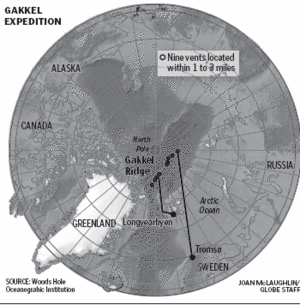Led by researchers from the Woods Hole Oceanographic Institution -- and equipped with unique robotic vehicles designed to explore mountain ranges miles beneath the polar ice cap -- 30 geophysicists, biologists, engineers, chemists, and other deep-sea specialists will depart July 1 from a remote Norwegian archipelago, Svalbard, aboard a powerful icebreaker that will smash a path to exploration sites near the geographic North Pole.
The Arctic, its mysteries concealed beneath thick ice, is the smallest but least known of the world's oceans.
"This is about exploring a portion of the earth that has been largely inaccessible to science," said Robert Reves-Sohn, a geophysicist from the institution who will be chief scientist on the 40-day voyage.
"We're looking for underseas habitats and creatures never seen before," he said during a news conference yesterday.

|
| ©Boston Globe |
| Gakkel expedition. |
The major aim of the Arctic Gakkel Vents Expedition is to seek out exotic life forms believed to thrive near deep-lying hydrothermal vents. Known as "black smokers" because they exhale dark minerals as well as superheated water, such volcanic vents have been discovered in the Pacific and Atlantic -- succoring bizarre 10-foot-long tubeworms and a strange species of swarming shrimp at depths and pressures that should by all logic be frigid and lifeless.
Until 2001, when a scientific vessel detected minerals in Arctic waters suggestive of such vents, it was thought that geological conditions under the ocean weren't right either for the boiling jets or the strange creatures surviving on their fringes.
The $5.5 million expedition marks the first search for life in the depths of the high Arctic.
"This is one of the key areas of the world where we might make big leaps in understanding biodiversity," said Timothy Shank, a hydrothermal vent biologist on the oceanographic institute's Arctic team. "We're quite sure the vents are there. And wherever we've found vents, we've found new forms of life. So we're expecting to find new life on the Arctic floor."
A big chunk of the research money comes from NASA, which hopes that vehicles tough enough to withstand Arctic conditions might serve in a future hunt for life on one of Jupiter's moons, Europa, which also features volcanic activity beneath an icy surface.
The Arctic venture will focus on the Gakkel Ridge, the northernmost extension of a chain of undersea volcanic mountains crosshatching the globe. The ridge, which stretches 1,100 miles, lies 1.8 to 3 miles beneath the ice cap.
It separates the North American tectonic plate from the Eurasian plate and is slowly widening, creating deep fissures over the course of millennia. From these cracks, or vents, water heated to more than 600 degrees bursts from the earth's mantle into icy saltwaters, creating an ecosystem of stunning temperature extremes.



Reader Comments
to our Newsletter